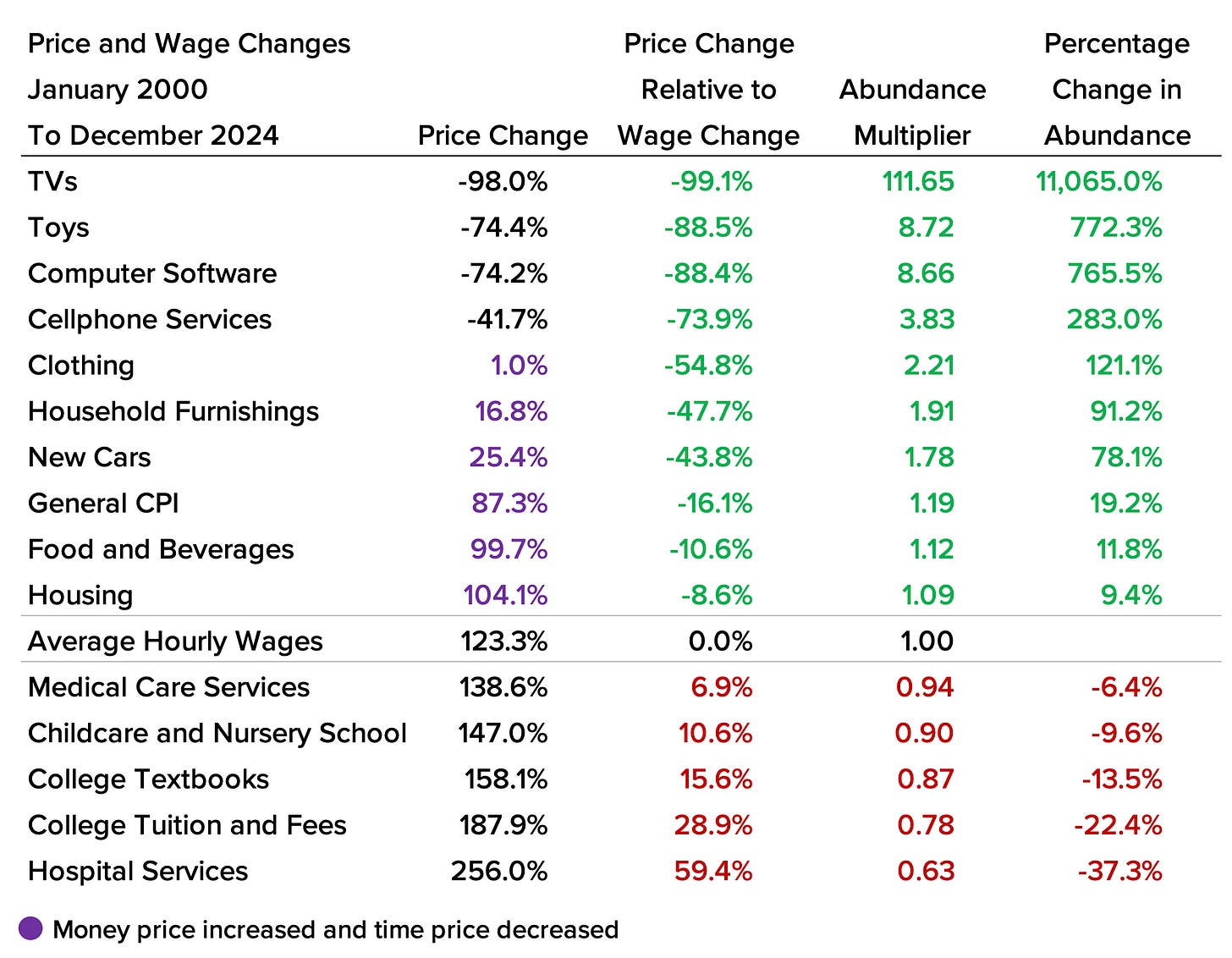Time Pricing Mark Perry's Chart of The Century
Always compare prices to hourly wages to get the true change in living standards.
Professor Mark Perry recently posted his updated “Chart of the Century” with price and wage data from the Bureau of Labor Statistics (BLS). The chart tracks 14 items over the 24-year period from January 2000 to December 2024, and also includes the overall inflation rate and the change in average hourly wages.
To examine the data from a different perspective, we calculated the change in time prices of these 14 items relative the change in the average hourly wage rate. We then calculated the abundance multiplier—a value that indicates how many units you could buy today for the time it took to buy one unit in 2000. If there was no change, the abundance multiplier would be equal to one. A value below one indicates decreasing abundance, while a value above one reflects increasing abundance. We also calculated the percentage change in abundance for each item.
This analysis illustrates that things can become more expensive in dollar terms while simultaneously becoming more affordable in time prices. For instance, while the general Consumer Price Index (CPI) rose by 87.3 percent, average hourly wages increased by 123.3 percent. As a result, time prices fell by 16.1 percent. For the time it took to earn the money to purchase one CPI basket in January of 2000, a consumer could get 1.192 baskets in December of 2024—an abundance increase of 19.2 percent.
Notably, categories such as housing, food and beverages, new cars, household furnishings, and clothing all increased in money prices. However, after adjusting for rising wages, they all became more affordable in time-price terms. Although 10 of the 14 items rose in nominal prices over the 24 years, only five had a higher time price when accounting for the 123.3 percent increase in hourly wages.
We also prepared a chart showing the percentage change in abundance for the general CPI and each of the 14 tracked items:
Every week I try to write an article on economics here on Gale Winds. Subscribe to get each article in your inbox — choose Free if money is tight, or choose $5 a month to help keep the lights on. You can also follow me on X at @gpooley.
We just released The Best of 2024. It includes 50 stories about the growth in abundance on our infinitely bountiful planet. The book is a great gift for a young person who might be worried about too many people on the planet. Or for an older person who thinks resources are finite. (Get one for Thanos).
Order yours today. It’s sure to be a collector’s item. Thanks again for reading Gale Winds. We look forward to another year of discovering and sharing all of the creative superabundance around us.
Gale Pooley is a Senior Fellow at the Discovery Institute, an Adjunct Scholar at the Cato Institute, and a board member at Human Progress.
Please visit Superabundance.com for more videos and reviews.








Isn’t the thesis of Abundance by Ezra Klein, Derek Thompson closely related to the thesis in this article? Interesting that there might be some convergence on where, how institutional reform needs to occur vs the chainsaw method.
1. College tuition and fees is meaningless as it does not account for financial aid (non student loans)
2. Hospital services numbers *may* be suspect too if they are, as they often are, “per visit”, rather than “per procedure” (number of procedures per visit has been increasing over time)